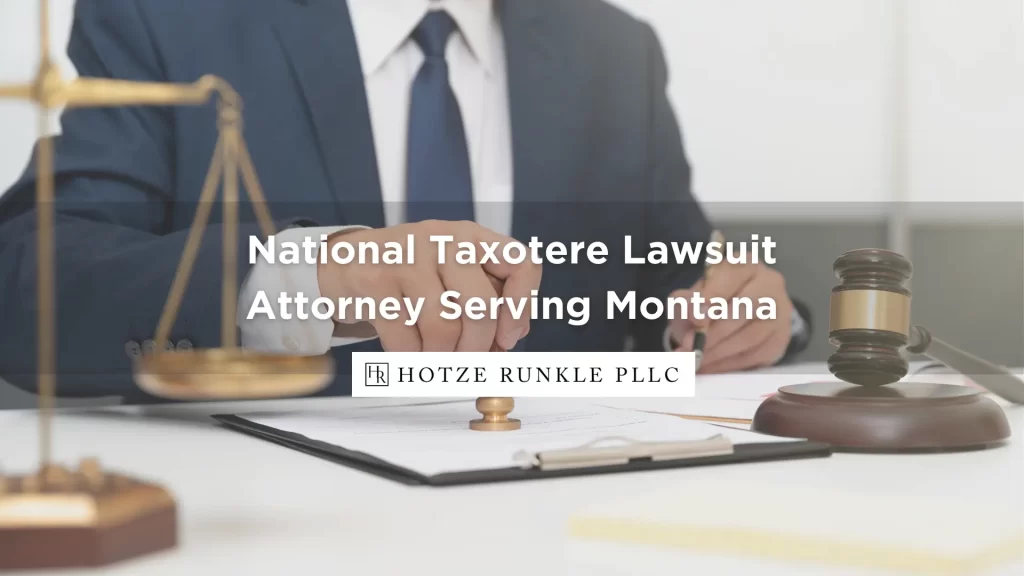
If you suffer from severely watery, teary eyes as a result of your chemotherapy treatment, it’s possible you may have developed a severe – and sometimes permanent – ocular side effect of the chemotherapy drug, Taxotere.
Taxotere is a common chemotherapy drug used mainly for breast cancer, but it’s also useful in treating other forms of cancer. The pharmaceutical company, Sanofi-Aventis, has received numerous complaints of the drug’s dangerous side effects. Cancer patients and survivors have come forward, stating that Taxotere causes symptoms such as blurry vision, excessive eye-watering, and eyelid swelling. Those symptoms are commonly associated with a serious eye disorder called canalicular stenosis.
The manufacturer failed to warn patients and doctors about this severe side effect of Taxotere, which can sometimes become permanent and require a risky, costly surgery. It’s hard to conceive that many patients fought cancer only to find a new medical challenge ahead of them.
Hotze Runkle PLLC represents clients who developed canalicular stenosis after undergoing Taxotere treatment. Our attorneys have helped many clients throughout Montana and the nation secure financial compensation that helped them rebuild their lives. We can help you, too. You might be eligible for financial compensation, whether your Taxotere regimen was weekly or less frequent, such as every two weeks, or every three weeks. Take our quick and easy quiz to get started.
Canalicular Stenosis: What It Is and How It Develops
Many patients have complained of excessive eye-watering resulting from their Taxotere chemotherapy treatment.
When functioning correctly, tears are supposed to pass from the tear ducts to the nasal cavity through a structure called the canaliculus. When debris gets into the canaliculus, it can lead to chronic inflammation. If the inflammation doesn’t get treated, this can cause an infection. As the infection progresses, it creates a blockage or obstruction in the canaliculus that prevents tears from funneling through correctly, causing them to run down the face, instead.
Without early intervention, the canaliculi will start to close, leading to canalicular stenosis.
Canalicular stenosis is an irreversible medical condition. You could potentially manage some of your symptoms; however, there’s no cure to eradicate it entirely. The most commonly reported symptoms include:
- Excessive eye-watering
- Swollen eyelids
- Blurred or cloudy vision
- Sensitivity to light
- Infection
- Dry eyes
- Headaches
- Cystoid macular edema (central vision loss)
Your symptoms can range from mild to severe, while many people say that it’s debilitating and disrupts their daily lives. It can interfere with routine tasks, such as driving and reading, and prevent you from functioning at work. For many, it’s overwhelming and diminishes their quality of life.
How Does Taxotere Cause Eye-Watering?
Sanofi-Aventis created Taxotere to prevent cancer cells from spreading to other areas of the body. Depending on the stage and type of disease, an oncologist administers the drug on a specific schedule. It’s proven most effective in common cancers, such as breast, lung, stomach, prostate, head, and neck.
Medical researchers have documented the link between Taxotere and canalicular stenosis. As the drug travels through the patient’s body, it interacts with various bodily fluids. Secretions come in direct contact with tears as they pass through the canaliculi into the nasal cavity. A reaction to the drug leads to chronic inflammation, resulting in canalicular stenosis symptoms.
Managing the Symptoms Associated with Canalicular Stenosis
Once you notice consistent watery eyes, it’s essential to seek medical treatment immediately. When caught early, your doctor can manage your symptoms and prevent them from getting worse. Notify your oncologist of the symptoms you’re experiencing and undergo an evaluation by an ophthalmologist.
An ophthalmologist will monitor your health and try to manage your canalicular stenosis symptoms. It’s possible to continue your chemo treatment, as long as you receive proper care to ensure your canaliculus don’t close entirely.
Canalicular stenosis is a permanent medical condition with no known cure. You can try to manage your symptoms; however, sometimes you must undergo an invasive and expensive surgery. DCR, dacryocystorhinostomy, aims to create a new passageway for your tears to travel through by placing a stent into your nasal cavity structures. That allows your tears to bypass the obstructed canaliculus and drain properly. In some situations, the placement of a stent is necessary to facilitate the flow of tears.
Due to the sensitivity of the eye area and surrounding structures, DCR could cause a range of symptoms more aggravating than your canalicular stenosis. The risks you face include:
- Excessive bleeding during and after surgery
- Permanent facial scarring
- Partial or total blindness
- Displaced stent
- Additional eye infections
- Abnormally fused tissue
- Ineffective procedure
If you allow your condition to progress, you might not be a good candidate for DCR. More severe cases could require CDCR, conjunctivodacryocystorhinostomy. When your canaliculus obstruction is so severe that it’s not possible to reconstruct a new tunnel for tears, your ophthalmologist could attempt CDCR.
CDCR requires placement of a glass tube called a Jones tube where the canaliculus was so tears can flow into the nasal cavity. It’s just as invasive as DCR and comes with the same risks.
Holding Sanofi-Aventis Responsible for Your Symptoms
Sanofi-Aventis released marketing materials for years without warning the public of Taxotere’s dangerous side effects. In 2014, they finally informed the FDA of symptoms associated with the chemotherapy drug. Allegations from breast cancer survivors around the country stated that the manufacturer knew about the harmful side effects but failed to warn physicians and patients.
It’s an overwhelming feeling when you decide to file a lawsuit against a large pharmaceutical corporation. Big pharma is intimidating and hides behind their expensive lawyers. Anyone considering going up against them alone has an uphill battle in front of them.
You have a right to hold Sanofi-Aventis responsible for their unethical actions. Their disregard for the health of breast cancer patients is deceitful and shocking. Despite knowing about the potential side effects, they failed to disclose it to those undergoing chemotherapy.
If you took Taxotere and developed any symptoms of canalicular stenosis, you may be entitled to compensation from the drug company. Seeking justice is your right. Companies like Sanofi-Aventis shouldn’t get away with knowingly selling a dangerous product. Your diagnosis led to suffering, your inability to work, and overall diminished quality of life. Hotze Runkle PLLC can help you pursue the compensation you deserve.
How Much Are Legal Fees?
 Hotze Runkle PLLC has provided honest, trusted legal representation to numerous victims of defective drugs, and we can help you, too.
Hotze Runkle PLLC has provided honest, trusted legal representation to numerous victims of defective drugs, and we can help you, too.
If you don’t know your rights or deadlines to adhere to, you could risk getting taken advantage of by the opposing party. Pharmaceutical companies enlist the help of an intimidating legal team that coerces the plaintiff into accepting less money than they should. If you’re not aware of the maximum settlement available, you could end up walking away with a fraction of the compensation you deserve.
Hotze Runkle PLLC wants to put your mind at ease and relieve your financial burden. We work on contingency, which means there are no upfront fees or costs. While your case is ongoing, you won’t receive any bills for our time and effort. Our legal fee comes out of your settlement when we resolve your lawsuit. We don’t get paid unless you get paid.
Seeking Compensation for Your Damages
Montana law dictates the amount of compensation you’re entitled to, based on your total losses. In a lawsuit, there are two types of damages: economic and noneconomic. Economic damages are for tangible expenses, such as medical costs, while noneconomic damages are for intangible losses, such as emotional suffering. You could potentially seek compensation for the following damages:
- Medical treatments
- Lost wages
- Pain and suffering
- Emotional trauma
- Loss of consortium
To win a financial award in your case, you need to establish that at least one of the following three factors existed:
Manufacturing Defect: When a product leaves the manufacturer in a condition that isn’t intended.
Defective Design: A product that fails to perform as safely as a reasonable person expects.
Failure to Warn: This occurs when the manufacturer doesn’t warn its users of the potential dangers of the product.
You must also file your lawsuit based on either negligence or liability on the part of Sanofi-Aventis.
Negligence
- Sanofi-Aventis owed you a duty of care;
- The drug company breached that duty; and
- The breach caused your symptoms.
Liability
- Sanofi-Aventis sold Taxotere in a dangerous condition;
- The condition existed when it left Sanofi-Aventis’ control; and
- That condition led to your symptoms related to canalicular stenosis.
The amount of compensation you receive depends on various factors, such as the severity of your diagnosis and the duration of necessary treatment. You could pursue a higher monetary award if you developed a permanent condition that resulted in life-long expenses for medical care.
Diagnosed with Canalicular Stenosis? Contact Hotze Runkle PLLC Today
Hotze Runkle PLLC offers a free consultation to prospective clients. When you schedule your initial appointment, one of our attorneys will review your symptoms and determine if we can move forward with your case.
We believe in fighting for justice and holding companies responsible for their negligence. Sanofi-Aventis shouldn’t get away with putting your health at risk. We know it’s been a steep road to navigate, and we want to help you recover and move forward with your life.
You can depend on us to be there for you throughout your whole case. We’ll handle all the legal aspects for you and try to reach a favorable outcome efficiently. It’s our goal to make sure you receive the maximum compensation available to cover your expenses.
To determine if you should file a lawsuit against Sanofi-Aventis for your canalicular stenosis symptoms, take our Taxotere quiz today.